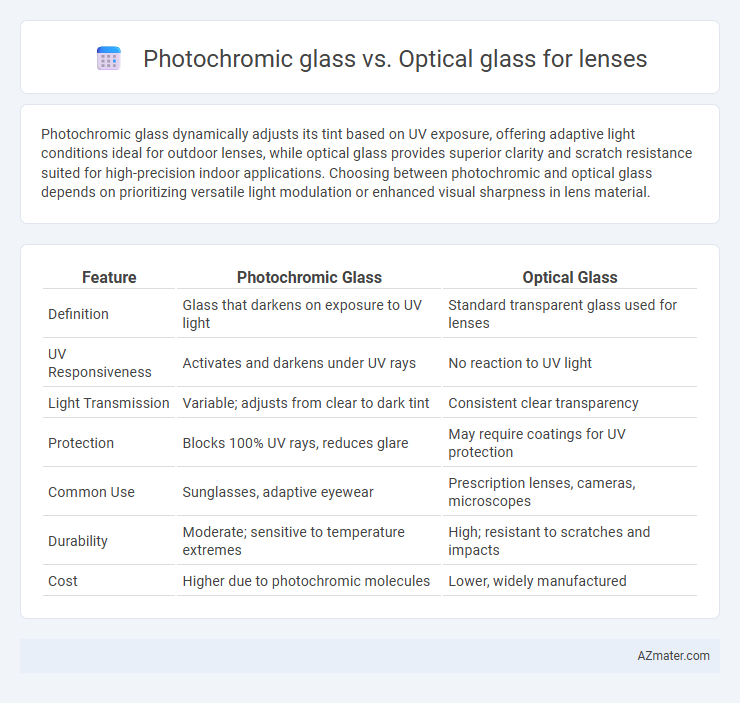Photochromic glass dynamically adjusts its tint based on UV exposure, offering adaptive light conditions ideal for outdoor lenses, while optical glass provides superior clarity and scratch resistance suited for high-precision indoor applications. Choosing between photochromic and optical glass depends on prioritizing versatile light modulation or enhanced visual sharpness in lens material.
Table of Comparison
| Feature | Photochromic Glass | Optical Glass |
|---|---|---|
| Definition | Glass that darkens on exposure to UV light | Standard transparent glass used for lenses |
| UV Responsiveness | Activates and darkens under UV rays | No reaction to UV light |
| Light Transmission | Variable; adjusts from clear to dark tint | Consistent clear transparency |
| Protection | Blocks 100% UV rays, reduces glare | May require coatings for UV protection |
| Common Use | Sunglasses, adaptive eyewear | Prescription lenses, cameras, microscopes |
| Durability | Moderate; sensitive to temperature extremes | High; resistant to scratches and impacts |
| Cost | Higher due to photochromic molecules | Lower, widely manufactured |
Introduction to Photochromic and Optical Glass Lenses
Photochromic glass lenses automatically adjust their tint in response to ultraviolet light, providing adaptive vision for varying outdoor and indoor environments. Optical glass lenses, composed of specialized glass materials, offer superior clarity, minimal distortion, and high refractive indices for precise vision correction. Both lens types enhance visual comfort but differ in functionality, with photochromic lenses emphasizing light adaptability and optical glass lenses prioritizing optical performance.
Understanding Photochromic Glass: Features and Mechanism
Photochromic glass features molecules that react to ultraviolet (UV) light, causing the lens to darken automatically in bright sunlight and revert to clear indoors. This mechanism relies on chemical compounds such as silver halide or organic photochromic dyes embedded in the glass or plastic substrate, enabling adjustable light transmission based on exposure. Unlike traditional optical glass, which maintains a consistent transparency, photochromic lenses combine vision correction with adaptive light filtering for enhanced comfort and eye protection.
What is Optical Glass? Key Properties and Types
Optical glass is a specialized material designed for lenses and optical instruments, characterized by high transparency, precise refractive indices, and minimal dispersion to ensure clear image formation. Key properties include controlled refractive index, low birefringence, high homogeneity, and resistance to thermal and mechanical stresses. Types of optical glass range from crown glass with low dispersion to flint glass with higher refractive indices, each tailored for specific applications in cameras, microscopes, and corrective lenses.
Light Adaptability: Photochromic vs Optical Glass
Photochromic glass offers superior light adaptability by automatically darkening in response to UV exposure, providing enhanced protection and comfort in varying light conditions. Optical glass, while highly precise in lens crafting, lacks the ability to adjust to changes in light intensity without external coatings or additional accessories. This inherent responsiveness of photochromic glass makes it ideal for users requiring versatile vision solutions in dynamic environments.
UV Protection: Which Lens Offers Better Safety?
Photochromic glass lenses provide superior UV protection by automatically darkening in response to sunlight, effectively blocking 99-100% of harmful UVA and UVB rays. Optical glass lenses, while known for their clarity and scratch resistance, typically require additional UV coatings to achieve similar levels of UV protection. Choosing photochromic lenses ensures enhanced safety by adapting dynamically to varying light conditions, offering both convenience and reliable ultraviolet defense.
Performance in Different Environments
Photochromic glass adapts dynamically to changing light conditions by darkening in bright sunlight and clearing indoors, enhancing visual comfort and reducing glare in outdoor environments. Optical glass provides consistent clarity and color accuracy regardless of lighting but lacks the reactive tinting properties of photochromic lenses. In environments with variable lighting, photochromic lenses outperform by improving eye protection and reducing the need for multiple pairs of glasses, while optical glass excels in controlled or low-light settings where stable vision quality is critical.
Durability and Longevity Comparison
Photochromic glass lenses are engineered with embedded molecules that react to UV light, providing adaptive darkening capabilities but may experience gradual wear in photochromic performance over time due to repeated exposure cycles. Optical glass lenses are manufactured from high-quality silica-based materials offering superior scratch resistance, chemical stability, and long-lasting clarity without change in transmissivity. Durability assessments highlight optical glass as more resilient against physical abrasion and environmental degradation, while photochromic glass may require replacement sooner to maintain optimal photo-responsive functionality.
Price Comparison: Cost-Effectiveness Analysis
Photochromic glass lenses typically cost 20-30% more than standard optical glass due to their light-adaptive technology, which provides photochromic lenses enhanced UV protection and convenience for outdoor use. Optical glass lenses remain a cost-effective option for users seeking high clarity and scratch resistance without the added expense of light-reactive features. For budget-conscious consumers, investing in optical glass offers strong performance at a lower price point, while photochromic glass delivers added value in variable lighting conditions despite the higher initial cost.
Ideal Use Cases for Each Lens Type
Photochromic glass lenses are ideal for individuals who frequently move between indoor and outdoor environments, as they automatically darken in sunlight to protect against UV rays and reduce glare. Optical glass lenses excel in precision vision correction and are preferred in applications requiring high clarity and durability, such as prescription glasses and specialized optical instruments. Choosing between photochromic and optical glass depends on specific lifestyle needs, balancing adaptability to changing light conditions versus consistent optical performance.
Conclusion: Choosing the Right Lens for Your Needs
Photochromic glass offers dynamic light adjustment by darkening in sunlight and clearing indoors, ideal for outdoor activities and variable lighting conditions. Optical glass provides superior clarity, scratch resistance, and precision in lens crafting, making it suitable for prescription eyewear and tasks requiring high visual accuracy. Selecting the right lens depends on your lifestyle needs: choose photochromic lenses for convenience and UV protection, or optical glass lenses for optimal vision quality and durability.

Infographic: Photochromic glass vs Optical glass for Lens
 azmater.com
azmater.com